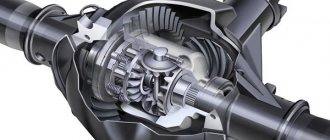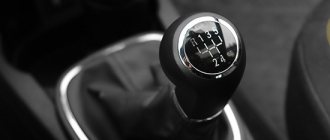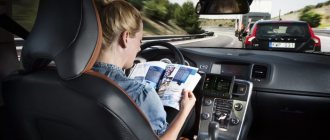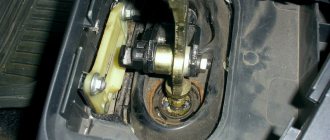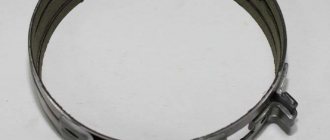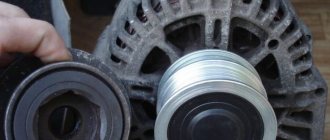As you know, the main purpose of the transmission is to transmit torque from the engine to the drive wheels. At the same time, the transmission not only transmits, but also converts torque. Most drivers know that a manual transmission has low and high gears. Conventionally, 1,2 and 3 can be considered reduced, 4 is considered to be direct transmission, while 5 and 6 are increased.
Let us immediately note that in relation to SUVs, trucks and various types of equipment, such a conditional division is not enough. The fact is that the gearboxes on such cars have not only “low” and “high” gears, but also so-called downshifts. Next, we'll look at why downshifting is needed, what it is and how it works, and how to use downshifting.
Downshift and its purpose
Simply put, a reduction gear is the one that is located in the transfer case, or otherwise, an additional box that distributes torque between the two drive axles. When it is turned on, the vehicle speed decreases, and torque and power increase. This gear is often used when overcoming obstacles such as ice, ford, steep descent or ascent, sand, mud, rocky roads and severe off-road conditions.
It is activated by a button or lever marked L and LO, which is short for low. The principle of downshift is that when it is engaged, the speed of the SUV decreases, but at the same time it becomes stronger and more capable of overcoming obstacles. The amount of speed drop depends on the gear ratio in the gears. When downshifting, the car moves at high speeds.
For example, consider a situation where, during a long climb in third gear, the engine does not have enough power, and when engaging second gear, the number of revolutions becomes too high. In this case, engaging a lower gear helps to cope with the situation: the car moves at low speed, but at high speeds. Thanks to the increase in torque at the wheels, overcoming obstacles on the road becomes much easier. The speed of the axle increases along with the gear ratio of the secondary shaft. Due to this, the car can more easily overcome severe off-road conditions, water obstacles, descents and ascents and other obstacles.
Switching gears while moving
In the recommendations for operating cars, there is the following point: “Switching the manual transmission must be done at certain speeds and tachometer readings . This increases the service life of the gearbox and engine, improves driving efficiency and protects the environment.
It is advised to change gears at 2-3 thousand revolutions according to the tachometer. If it is not there, then we focus on speed. Experienced drivers say that it is better to shift at the beginning of the climb and stay in a lower gear until the hill ends. If you switch while driving up a hill, you can lose the dynamics of the movement, the engine speed will drop and it will be more difficult for the engine to overcome the obstacle. This leads to increased wear of internal combustion engine parts and increased fuel consumption.
There are gearboxes with a large number of speeds. They are needed more to save fuel and reduce emissions of harmful substances.
Consider the stages of switching in motion
- Let's eat. Release the gas pedal and simultaneously press the clutch. The pressure should be smooth, but not slow
- We shift the gearbox to neutral and then to the desired gear. Switching on mechanics occurs only through the neutral position. Experts recommend taking a short pause when changing from one gear to another. This will save the box. They advise you to count to two. That is, the lever is in one position - we count “One” and move it to neutral. We count “Two” - turn on the desired gear
- Smoothly release the clutch pedal, without sudden movements of the foot. Having brought the clutch to the point of setting, squeeze approximately halfway. If you release the clutch pedal sharply, the car may jerk or it will “peck” its nose, and your face will hit the steering wheel. Lightly press the gas.
- Keep the gas pedal slightly pressed so that the engine does not howl, because the clutch is in the middle position
- Smoothly release the clutch completely.
- We take our foot off the pedal. It's better to move her to the side so she can rest
Advice for beginners and more. Never keep your foot on the clutch pedal unless you want to change gears. Take this as a rule or develop this habit in yourself - switch, move your leg to the side .
If you do not adhere to this rule, you can quickly destroy the gearbox release bearing. Even when the pedal is slightly pressed, the bearing begins to work. During long trips, its resource is sharply reduced, because it is constantly pressed against the plates of the gearbox basket, and it needs to rest. It is activated only when changing gears; the rest of the time it should be inactive.
Common Mistakes
Let's consider the erroneous actions of beginners or those who switched from automatic to manual. They can lead to premature transmission failure.
- Not changing gears in a timely manner. They do not pay attention to the speed of the car and engine speed
- Slowly move the manual transmission lever. As mentioned above, you need to switch clearly and relatively quickly, on the count “2”. If this is done smoothly, the car will begin to brake with the engine. While you switch, you will need to accelerate again to keep up with city traffic.
- Smoothly pressing the clutch pedal leads to a decrease in driving speed. At the moment of changing gear, you release the gas and begin to press the clutch. At this moment, the box is in rigid coupling with the motor. Since the accelerator pedal is not pressed, fuel is not supplied, the engine begins to slow down the car. Therefore, we press quickly until we lose speed, switch gears and smoothly release the pedal.
- They release the clutch pedal sharply. This will cause the machine to jerk and jerk. As a result, you can bump your nose into the steering wheel and damage the gearbox elements.
Demultiplier
The multiplier is structurally included in the transfer case circuit or is designed as a separate unit. In automatic transmissions, the transfer case may not be present, and its functions are performed by some parts and components in the gearbox. An additional gearbox, which has a reduction gear (multiplier), is designed to increase traction forces on the wheels. The multiplier is a transmission mechanism that is designed to increase torque. It is installed, as a rule, on those cars that are intended for use in poor road conditions. In this case, the usual number of gears in the box will not be enough; obtaining an intermediate gear ratio in the transmission will help here.
Let's consider this situation: in fourth gear at a certain speed, the engine operates under specific conditions with overload; in lower gear, third, the engine is “overtwisted.” In this case, an additional gearbox will help.
Extending the life of automation
First of all, the performance potential of the automatic transmission is determined by careful operation. An important factor that prolongs the durability of the mechanism is timely and high-quality maintenance.
The duration of a comfortable ride on an automatic transmission will be longer if you constantly monitor the oil level in the box. Using a dipstick from the engine will help sort this out. The main thing is to prevent leaks by changing the oil and filter. It is advisable to do this every 40–60 thousand km. Also, do not save money; it is better to use the original product.
In terms of operation, automation is many times more complex than mechanics. Moreover, such a transmission is more suitable for traveling around a metropolis. There’s just a nuance: the machine doesn’t like high overloads. Do not torture the system until it warms up. This is especially true in winter.
Once you change from a manual to an automatic, you can confidently say: you won’t change back.
How to downshift?
It is necessary to stop the car, after which the main gearbox lever is moved to the neutral position, and the additional gearbox lever is moved to the “low gear” position. Then we depress the clutch. Not all transmissions have a separate transfer case. In this case, a regular gearbox has a special lever with which this gear is engaged. If downshift is engaged in normal mode, then there is a high risk of overloading both the engine and transmission. As a result, both units may fail.
Purpose of double squeeze
Mechanisms such as synchronizers facilitate the process of gear shifting, making it smooth. At the same time, wear is reduced and the specific grinding noise characteristic of older models is also eliminated. If there are no synchronizers or they are broken, you cannot do without double squeezing.
So why is it really needed? The need is due to the equalization of engine speed by gears and shafts. Otherwise, these parts may jam at best. In practice, this happens as follows: moving at first speed, the engine speed is increased to three thousand revolutions. To switch to second, you need to release the gas, squeeze the clutch, go to neutral. Then wait until the speed drops and press the clutch again, switch to second. In this way, the shafts are equalized without damaging the gearbox. Then you can move on calmly.
In the case of re-gassing, the process is a reverse action. This implies reducing the gear without putting the gearbox to sleep. If you need to turn on the road, but it is impossible to do this in fourth gear, you must slow down and lower the gear. Otherwise, there is a risk of stalling. You can smoothly release the gas by squeezing the clutch and move to neutral. The next action will be to gain momentum. To do this, you will have to activate the gas pedal, in other words, make a shift. That's it, after that we managed to increase the speed. Synchronization with the shaft has occurred. You can now downshift and continue driving.
It is recommended to adhere to the throttle pause at neutral during the process. The main thing here is to catch the right clutch moment in time to prevent the car from stopping. Skills come with experience, of course. Therefore, there are no special skills or secrets here.
The question arises: why is this necessary when modern cars are equipped with synchronizers? If you remember that often the road is not perfectly smooth, there are always some obstacles.
Therefore, synchronizers may fail on the first bump or climb. This is where re-gassing comes to the rescue. For example, when going up, you realize that this transmission cannot pull you through. There are simply not enough revolutions, the throttle is overloaded. This allows you to switch to a lower gear without losing the necessary inertia.
Application of reduction gear and differential lock
So, as we already understood, downshift is an additional gear that reduces the number of wheel revolutions at constant engine speeds. It is usually installed in the transfer case. Its presence makes the SUV more expensive, heavier and more complex. But on economy class cars it is not always installed; instead, the connection of the power take-off shaft to the rear axle gearbox occurs in the gearbox, in the downshift housing. Recently, there are fewer and fewer frame SUVs, and crossovers are moving closer to city cars. These cars often lack downshifts. Now there is a tendency that the priority is the presence of comfortable conditions in the car rather than its off-road qualities. Most manufacturers are switching to a monocoque body, and the frame structure remains a thing of the past. Real jeeps are still those SUVs that have a reduction gear and a differential lock, thanks to which they are not afraid of any obstacles.
Differential locking is necessary to increase cross-country ability. The differential itself is divided into interwheel and interaxle. Previously, cars did not have such technologies, so their absence had a negative impact on the safety of elements in the structure. The wheel differential allows the wheels to rotate at different speeds; this is necessary, for example, if the car is making a turn. But its presence can lead to the fact that when slipping, the engine power will go only to the wheel that is stuck, while the other will be stationary. When the differential is locked, the engine energy will be distributed equally between the wheels, and thus the car will be able to overcome the obstacle.
The center differential is similar in its principle of operation: it allows the front and rear axles to move at different speeds and along different trajectories. But in some situations this can significantly complicate control: if the front wheels are stuck, the rear ones will be inactive. Locking the center differential can successfully solve this problem. SUVs, known for their excellent cross-country ability, are usually equipped with three locks: rear, front and center differential.
What's the result?
As you can see, low gearing in a car that is positioned as an SUV is a necessity. In this case, the efficiency of the reduction gear itself will depend on the gear ratio.
Finally, we note that the driver must also be able to use downshifts correctly, since errors can lead to breakdowns of both the transmission itself and, in some cases, the car engine itself.
All-wheel drive device, types and types of all-wheel drive, diagram of the drive device on all-wheel drive cars. All-wheel drive boxes, features.
Gearbox differential: what is it, differential design, types of differentials. How does a gearbox differential work in a car transmission?
Which gear to choose and what is the correct shifting algorithm is a seemingly trivial question, but only for those who are used to driving a manual transmission and have been doing this for quite a long time. The note is intended for those who intuitively have switching skills. To gain basic knowledge, I recommend that you first read the note.
Types of reduction gears
Worm, less often cylindrical and planetary gears are used as reduction gears. The worm gear is one of the gearing gears with intersecting shaft axes. Movement in them is carried out according to the principle of a screw pair. Its main properties are low noise level due to the characteristics of the gearing, relatively low efficiency, small dimensions and large gear ratio. Compared to a helical gearbox, a worm gear provides better running smoothness. This type of transmission has a much greater potential for increasing torque and reducing rotation speed than gearboxes with other types of gears. Spur gears are used in mechanisms with parallel shafts. This type requires increased accuracy due to design features.
Gear drives are distinguished by their reliability and durability while maintaining the permissible load level; the disadvantages include the fact that at high rotation speeds such a mechanism has a high noise level and also cannot flexibly respond to changing loads. Planetary gears are also a type of gear. They have gears with movable axles. Such gears are lightweight, easy to assemble, produce less noise compared to conventional gears, and also have the ability to obtain large gear ratios. Disadvantages include a large number of parts, increased requirements for installation and manufacturing accuracy.
Source
Demultiplier as part of the turning mechanism of a tracked vehicle [edit | edit code]
Some types of planetary turning mechanisms for tracked vehicles, the design of which includes two two-speed differential gearboxes, make it possible to implement the range-multiplier function through simultaneous group (paired) switching of both gearboxes from one operating mode to another - from high gear to low gear. In this case, as in the case of the range multiplier that is part of the gearbox, the output torque increases with a simultaneous decrease in rotation speed. This option is only a consequence of the ability of such turning mechanisms to provide two gear ratios for maneuvering and is not formally a range-multiplier, although it can be used like one.
Contrary to the widespread belief that there is a range option in the turning mechanisms of the vast majority of tracked vehicles, in fact it was present only on relatively old vehicles: British Cavalier, Covenanter, Crusader tanks; Czech tank LT vz.38; Hungarian Turan tank; Japanese tank 三式中戦車 (Chi-Nu); Soviet tanks IS-1, IS-2, IS-3, T-44, T-54, T-55, T-62; Soviet combat vehicles BMP-1, BMP-2; Soviet tracked tractor AT-S. Also, some little-used dual-flow turning mechanisms on modern vehicles, similar to those on the Panther tank, have a similar option: the Panther itself, the Soviet AT-L tracked tractor, the Soviet MT-LB and MT-LBu tracked combat vehicles.
First of all, let's say that the gears of any transmission are designed to regulate the speed of transmission of torque from the engine to the drive wheels. They are divided into direct ones, as well as those that increase torque and decrease it. Here we will talk in more detail about the latter type.
Riding in difficult conditions
No matter what crossover owners fantasize about, their plug-in all-wheel drive is only enough to conquer the lawn near the house. To drive on sand, loose snow, and mud, you need a serious car and the ability to use it. Electronic systems on crossovers will not allow driving on such heavy surfaces - an attempt to force, for example, virgin snow, is guaranteed to end in digging into the snow and wheels slipping in place. The lowering gear is capable of providing constant and high torque to the wheels at low rotation speeds. Thus, the SUV is able to drive without throttle to the floor without slipping or bogging down.
An example when an emergency downshift may be needed
The ability to shift to a low gear can be useful in an emergency situation, for example, if the brakes fail. Often this need arises when traveling in icy conditions.
Let’s give a fairly common example from life: a road you know well, it’s summer, there’s not a hint of rain. You are driving along a flat road at a speed of 90 km/h, approaching a turn that you have passed with ease more than once.
However, when entering a turn, you notice with horror scattered sand on the asphalt. In fourth gear, the car will not have enough power to make a safe turn, and the car may fall off to the side of the road. It is in such a situation that an emergency switch will be needed.
Riding on tiptoes
But it’s not only snow and sand that lovers of active recreation have to overcome; there are also more difficult obstacles, for example, crust, a wet clay field or a swampy place in the forest. To drive in such places, you need to have considerable jeep experience and a car with a low gear. Even the slightest slip will lead to the wheel digging in, the tread becoming washed out and the need to hook up a winch or jack up the car. Experienced drivers bleed their tires before driving through such areas to ensure the largest contact patch and reduce ground pressure.
Do I need to change tire pressure in winter?
The first snow has already fallen in the Moscow region, more will follow, so novice jeepers will probably be tormented by the question, what to do with tire pressure? To reduce it or not.
The answer is:
You don't need to do anything. Leave the pressure the same, the snow chains are more important here. Therefore, if you go winter fishing or for some business to a snowy field, be sure to take chains with you.
The next time you find yourself far from the road, remember this reminder. By engaging all-wheel drive in time, you have less chance of getting stuck and will emerge victorious from the mud or deep snow.
The design of the transmission of many cars includes such a unit as a transfer case. Thanks to it, the drive on such cars is carried out on all wheels. The presence of a transfer case increases the vehicle's maneuverability and improves handling. This additional unit is equipped with both regular passenger cars and all-terrain models - SUVs and crossovers.
When is maximum power needed?
A low gear is very helpful when it is necessary to use all the capabilities of the car to the maximum, for example, when driving on mountain roads and passes, and when it is necessary to drag a heavy load uphill. Under these conditions, the transmission and engine of the SUV are under maximum load, and without a reduction gear the car simply would not be able to drive in such places. In addition, slipping on a hill is very dangerous, since the car can fall down the slope without being able to somehow control it.
When to use it
Experts and manufacturers recommend turning on the overdrive mode in the automatic transmission in the following cases:
- when accelerating the car, for example, when you overtake and move over 100 km/h;
- when you are driving on a bad road or even off-road;
- you are slipping a heavy trailer.
Despite many different opinions, it is also recommended to turn on overdrive in the city. This will not be difficult; the button on the lever will do it for you. The button is called O/D (on|off).
When this mode is turned on, this means that the automatic transmission will independently and sequentially shift from 1st to 4th gear. Afterwards, it will turn on the torque converter lock and make a push, do not take it as a transition to 5th speed, it is not. When driving at speeds of about 40 - 60 km/h, it is not recommended to use overdrive. Also turn it off if you are in traffic. After pressing, a special button will give a signal and the yellow light will light up. It is also recommended to turn it off when:
- you go up and down (long descent);
- when the pace of traffic on the road is constantly changing;
- if you drive less than 50 km/h.
It is also recommended to turn it on when:
- you are driving on the highway;
- eat for a long time without changing speed;
- you drive at high speeds, for example, over 120 km/h.
Off mode is displayed on the control panel
Low gear for jeeps
| Page 1 of 8 | 1 | 2 | 3 | 4 | 5 | > | Last » |
Good day to all!
There was a personal opinion that the main task of lowering is to protect the clutch from increased wear. This would also indirectly include the lack of power, the need for a minimum speed, avoiding slipping, etc.
But on a recent off-road trip, the drivers were discussing who was going uphill at which lower level. The starting speed was 30 km per hour. And you could easily drive up to the beginning of the hill in 2nd row, and if something happened, go to 1st row (regular row). I didn’t ask right away, but only later I thought about why in such and similar cases I would switch to a lower row. The car was a stock Niva, perhaps the choice of lowering is explained by the weakness of the engine.
Hence the question - in what cases is lowering really necessary? I came to the conclusion that there is no need to turn it down
, when there is enough reserve speed and power, the speed is high, but there is no speed, which is why I don’t have time to gain momentum and the car stalls.
Personal experience — Patriot is almost stock. You need to lower the gears when
the mode is creeping, and there is a need to “play” with the clutch.
These are not statements, but more of a personal opinion. The question seems simple, but in fact the action of other “machines” confused me. I would be grateful for an informed opinion on this issue - in which case to turn on the lowering.
Source
What are digital nomads like?
A prerequisite for digital nomadism is having a job that can be done from anywhere in the world with a stable and fast Internet connection. A digital nomad can be officially employed by one company, or be a freelancer with many clients, or even have his own business.
Our people go to the bakery by taxi
Banks and experts note changes in consumer standards
The main thing is that digital nomads are people who use technology to make a living while traveling. At the same time, they can either change host countries one after another, or lay low for some time in a place they like, if the visa regime allows.
If you drive more quietly, you’ll get stuck further...
Gearbox with reduction gear
As all off-road enthusiasts know, the true “coolness” of this class of vehicle is measured by the distance that must be traveled to find a tractor capable of extracting a carried away SUV or crossover from an insurmountable unevenness in the earth’s crust. One way to increase this distance is to have a reduction gear in the transmission. Downshift is an additional gear that reduces the number of wheel revolutions at constant engine speeds. Structurally, it is usually installed in a transfer case, which distributes torque from the engine to the front and rear wheels.
What is a synchronizer and what is it used for?
Synchronizer
- a design element of mechanical transmissions on shafts and gears of constant mesh, designed to synchronize the angular speeds of the locking clutch and gear when the gear is engaged.
Interesting materials:
What is the screen diagonal of iPhone 6 plus? What is the diagonal size of the iPhone 11 Pro Max? What is the diagonal size of iPhone 8 plus? What is the warranty for iPhones? What kind of camera does iPhone 8 plus have? What memory does the iPhone 11 Pro Max have? What's the difference between iPhone 11 and 11 pro? What's the difference between iPhone 7 and 7 plus? What SIM card is in iPhone 7 plus? What SIM is in iPhone 5S?
Why downshift?
To figure out why a reduction gear is needed, you will first have to look at the characteristics of the engines. Even car owners who are far from technology know that the maximum power developed by the engine is documented at a certain number of crankshaft revolutions. The reason is that both the power and torque of the engine depend on the speed. Gearboxes are designed in such a way that the engine can optimally deliver its power both when starting off and moving slowly, as well as at high speeds. You don't need a lot of power to get moving on hard surfaces. Therefore, the first gear has a gear ratio that provides a confident start and slow movement at just above idle speed. Engines from different manufacturers develop maximum power at 3-6 thousand revolutions. At the first, this already corresponds to a relatively high speed. As a result, there may not be enough power for steep climbs or on surfaces that offer resistance to movement (snow, mud, sand, water). If you “spin” the engine to 5 thousand to add torque, the gearbox will transmit high speeds to the wheels, which will begin to slip. Or it may happen that a speed of 10-15 km/h no longer becomes safe if the road is replete with stones, potholes, the risk of slipping off a cliff, etc. In all such cases, a reduction gear in the transfer case becomes an assistant.
Shift clutch
Gear shift couplings are mounted on the secondary shaft with freely rotating sides of the gears. Because the couplings are connected to the output shaft by splines, they are called splined couplings. Unlike the secondary shaft gears that rotate freely on bearings, couplings are capable of moving in the longitudinal direction. There are ring gears on the side surfaces of the secondary shaft gears and splined couplings. When moving along the splines, the clutch engages the ring gear with the gear ring, locking it on the shaft. Rotation from the intermediate shaft is transmitted to the driven gear of the secondary shaft, and from it through the ring gear and coupling splines to the secondary shaft. The longitudinal movement of splined couplings along the secondary shaft is carried out by gear shift forks, which are connected to the lever through sliders. Since there are two clutches (in a four-speed gearbox, in a six- or eight-speed gearbox there are more), a locking mechanism is provided to prevent the possibility of engaging two gears at the same time. When the clutch ring gears are connected to the secondary shaft gear determined by the gear selection, torque is transmitted through the driveshaft and the final drive to the drive wheels. The car is moving. If no clutch is connected to the secondary shaft gear, the gearbox is in “neutral”, the engine is disconnected from the transmission mechanisms, the car stands still or moves only by inertial forces.
Decreased or downgraded?
Downshift or downshift?
Car enthusiasts don’t often bother with precise wording. Most often you can hear “turned on (plugged in, turned on, connected...) lowered and go!” Which is correct: “low” gear or “lower”? Depends on the context. “Downgraded” means “one that is lower than others.” “Lowering” - “one that lowers.” If it is implied that a specific mechanism (a pair of gears, for example) is put into operation to transmit rotation with a decrease in the number of revolutions, it is correct to use the term “reducing”. If we are talking about switching to a gear that has a maximum gear ratio, i.e. maximally reducing the speed of rotation created by the engine and transmitted to the wheels by the transmission elements, then the term “reduced” is quite appropriate. So, simply switching to first from second should be called engaging a downshift, and moving the Niva transfer case lever to the forward position should be called engaging a downshift. A transfer case that includes a reduction gear makes the SUV heavier, more complex, and more expensive. Therefore, when developing “economy class” SUVs, designers try to save money by finding other solutions. The first example can be seen in the amazing, but lost to history, Soviet compact SUV - LuAZ. Its transmission does not include a transfer case at all. LuAZ is a front-wheel drive car. The power take-off shaft is connected to the rear axle gearbox in the gearbox, in the downshift housing. This scheme allows you to save metal, weight, space, but also has its drawback. Downgrade only works when moving forward. But how it works! With an engine of only 40 hp. “Luntik” can move through the mud at the speed of a tired pedestrian. If the wheels are spinning, the driver can get out without stopping, push his little hunchbacked horse, calmly wipe his hands and, slowly, catch up with the car and get into it.
Off-road leaders with crawler gearing
Let's start with domestic SUVs. UAZ may have different gear ratios in first gear, depending on the brand of gearbox:
Gear housings
Standardized cast gearbox housings are widely used in mass production. Most often, in heavy industry and mechanical engineering, housings are made of cast iron, less often of cast steel. When it is necessary to make the design as light as possible, light alloy bodies are used. The gearbox housing most often has attachment points - paws and/or ears, by which the gearboxes are moved and/or secured to the base. At the output of the shafts, seals are placed to prevent oil leakage. Structural elements are often placed on the gearbox housings to prevent an increase in pressure inside the gearbox resulting from the heating of the gearbox during operation.
Off-road without reduction
SUV with reduction gear KIA Sorento
In recent years, the trend towards increasing the civility of SUVs and crossovers has acquired a scale that is depressing for experienced jeepers. Real SUVs are chasing comfort, which leads to an increase in their prices, and often to a decrease in cross-country ability and closer proximity to crossovers. Crossovers, in turn, are becoming more and more similar to asphalt machines. There are practically no frame SUVs left. Many people part with downshifts. Following the flagships, other SUVs are also becoming lighter. So the KIA Sorento has remained without a downshift since 2009. What can we say then about crossovers! The Porsche Cayenne S with a 6-speed Tiptronic S transmission has a reduction gear, but since 2010 the Porsche 958 Cayenne has received a new version of Tiptronic with 8 steps, but without a reduction gear. The designers of the Audi Q7 also abandoned downshifts. A general trend is visible, the paradox of which illustrates the “spiral” nature of development. Modern crossovers, or rather that part of them that has some claims to the title of SUV, are simply supplemented with 1-2 steps in the gearbox. The transmission of a quite “budget” Renault Duster is designed in such a way that it is better to start on the asphalt in second gear, and leave first for driving on questionable roads. Actually, their designers repeat the line of thought of the LuAZ developers. Only with other tasks. The buyer is inclined to pay more for comfort than for the capabilities of the car. This is probably a real change in the needs of the majority of motorists. And for true connoisseurs of free movement in different directions, there remain the indestructible simple cars of the last century and the off-road supercars of the new century.
Source
Clutch when shifting gears
You described throttling when lowering, also with double squeezing. And I described upshifting. This is not nonsense, but quite a method of switching up: https://www.rallyfan.ru/driving/faq/gear.php see “Shifting from the bottom up” Although the terms “under-gas” and “re-gas” are still used more when describing downshifting rather than upshifting. Here's a good link about the downgrade: https://www.rallyfan.ru/driving/faq/19.php
There is no speedometer, and you won’t need a tachometer with experience either - you’ll switch by the sound of the engine. you just hold the gas pedal so that the speed does not drop to idle and does not rise too high - they are individual for each car - and when the clutch is engaged, the car continues to drive without “nodding”
Downgrade or accessible about complex
In our difficult age of nanotechnology and oil production in the Arctic, happy owners of “jeeps” are beginning to get used to turning on all-wheel drive with a beautiful button on the dashboard and rejoicing like children that they have a “real” SUV, but as soon as most of these monsters drive off-road from the asphalt, the owners begin remembering such an atavism as the lowering and swearing loudly at the overheated viscous coupling.
But you and I are real jeepers and we know that without lowering it’s not a jeep at all and life is bad without it, and that’s why when choosing a car we prefer, even if it’s from the last century and rotten like last year’s tomato, but still a real jeep. Not so long ago, in the process of building an iron horse, I had to delve into the question of what and why and with what it is eaten. Everyone talks smartly about some kind of Newtons, by the way, they like to mention them in test drives of any cars with such an air, as if the average car enthusiast is simply obliged to know how they affect the behavior of the car. Looking ahead, I will say that these numbers will not say anything if there is no understanding of what will ultimately reach the wheels. What got me the most was the arguments of more experienced comrades about which lowering of the transfer case is better: 4.16 or 4.9. For me personally, these are just numbers and there is no more meaning in them than in data on the population of Argentina. Strange numbers and clever words made my head spin and I wanted a button on the dashboard, instead of all this abstruse bullshit. But this is not our method, so I decided to figure out what kind of garbage this is and started studying the issue, in the process this article was born, since not a single sane source was found where the simple story was told, or rather, they were found, but they also wander into “abstruse distances” . I will try to explain everything as simply and clearly as possible. Let me make a reservation right away that in all calculations there will be many assumptions from the “let’s take one white horse in a vacuum” series, in particular we will not take into account friction losses, efficiency of units, etc., otherwise the formulas and calculations will be very long, whoever needs exact numbers will figure it out himself, we We will limit ourselves to a “general overview under ideal conditions.” So, take a deep breath and let's go!
We will assume that everyone knows the general principle of operation of the gearbox and there is no need to explain it, but if anyone is not in the know, then its task is to transmit the rotation of the engine, transforming it, depending on the selected gear, to the driveshaft, and then to the gearbox and wheels. But for driving without roads, it often turns out that “it would be necessary to lower it”; for this purpose they install a transfer case, that is, essentially another intermediate block of gears, which allows you to once again convert the rotation and lower the rotation speed. How it works? The simplest and most understandable example is a bicycle. Ever ridden a bike with a derailleur? Remember how it feels when the biggest gear is in front and the smallest in the back? It is very difficult to move a bicycle, but if it is moved, then for one revolution of the pedals it makes several revolutions of the wheel and flies like an arrow. What if it's the other way around? Yes, yes, you pedal in the soap, and the bike crawls like a turtle, but it crawls uphill and through mud and anywhere. Well, it’s the same with the lowering gear, only the engine works instead of you. In a lower gear, the load on the engine becomes noticeably less, and so does the speed, but it creeps anywhere and anyhow.
But on a bicycle everything is simple - two gears, on a car it’s also nothing complicated, but there are more gears and in almost every node the rotation is converted by one value or another. But let's take things in order. First, our engine spins a LARGE gear, which is called a flywheel. In the picture below, it's the big gear on the right.
Then this rotation is transmitted to the gearbox, then to the transfer case (if there is one), then through the driveshaft to the differential and then to the wheels.
Now mathematics and physics
.
As soon as you start to understand the question, some scary numbers come up that the interlocutors operate with, and you, like a fool, don’t understand anything, but you’ve already realized that this much percentage reduction is cool, and if 1k is still a certain amount, “it’s a tractor” , and at the same time it can be lowered in bridges. All these conversations begin when the question of real off-roading arises, when the standard lowering is no longer enough to rotate the wheels from the tractor, which you, having seen enough of more experienced comrades, put on the car for some reason.
So, let’s try to figure it out together, using the Suzuki Jimny as an example.
Let me make a reservation right away: the numbers are approximate and taken from the Internet, I could be wrong. To begin with, we open the manual and find the following data:
— Gear ratios in the gearbox - Gear ratios in the transfer case - Gear ratios in the differentials
We also need torque on the internal combustion engine and wheel diameter. Specifically for a gym bike it looks like this:
— In standard differentials (gearboxes, call them whatever you want) it is 4.3 (although there are others) — Also from the book, the maximum torque of the Suzuki Jimny is 110 Nm at 4500 engine speeds.
The question remains of the wheel diameter. You can simply measure with a tape measure or calculate using the formula.
The standard Jimny wheel size is 205/70/15. This means that the wheel diameter is 2 profiles + rim diameter = 205mm x 70% x 2 + 15 x 25.2 = 665mm or approximately 26.4 inches.
Well, it seems like we’ve stocked up on all the initial data and are starting to calculate the scary numbers. Although no, before bothering your head with this garbage, you need to explain why it’s all. And this is necessary so that you can better understand the physics of vehicle movement and be able to calculate the optimal reduction under increased loads. After all, the manufacturer did not at all expect that its products would be stuffed glass deep into the swamp and, accordingly, if you want greater cross-country ability without damaging the units, then you should think about lowering the standard values.
To begin with, we have an engine that transmits rotation to the gearbox; at what frequency it rotates we can see on the tachometer. Then we delve into the performance characteristics of the gearbox and find out that in first gear the reduction is 2.962 (for the AT gearbox), that is, at the output after the gearbox, the driveshaft will make almost three times less revolutions, roughly speaking, for 1000 engine revolutions we will get 337 driveshaft revolutions shaft Next comes the transfer case with a reduced gear ratio of 2.145, that is, behind the transfer case we already have 157 revolutions, and then we go to the axles, to the main pair, which has a reduction of 4.3, with a total output at the wheels of 36.5 wheel revolutions per minute per thousand revolutions on the engine. The total reduction is: iob=2.962×2.145×4.3=37.32
We can also calculate the torque at the wheels - this characteristic is much more real than abstract horsepower or engine torque.
You can understand what torque is using a simple example. Let's take a stick and clamp one end of it in a vice. If you press on the other end of the stick, a torque (Mkr) will begin to act on it. It is equal to the force applied to the lever multiplied by the length of the force arm. In numbers, it looks like this: if you hang a 10-kilogram load on a lever one meter long, a torque of 10 kg*m will appear. In the generally accepted SI measurement system, this indicator (multiplied by the value of the acceleration of gravity - 9.81 m/s2) will be equal to 98.1 N*m. It follows from this that more torque can be obtained in two ways - by increasing the length of the lever or the weight of the load.
The motor produces torque Mdv. After conversion by the transmission, this moment is transmitted to each drive wheel of the car in the form of Mk and forces the wheel to rotate, i.e. it creates a shear force Fct = Mk/R at the point of contact of the wheel with the road, and this force is applied to the road through the wheel. The road surface prevents the wheel from rotating by a frictional force Fрт of the same magnitude, but applied to the wheel and directed in the opposite direction. To show that forces act on different objects, the points of application of forces in the figure are conditionally slightly spaced vertically:
This friction reaction force Fрт, multiplied by the number of driving wheels, moves the car. In relation to jimny, the accelerating force will be 4Fpt. Let's determine this value. The engine develops maximum torque Mdv=110 N.m at 4500 rpm. This means that in first gear in the gearbox with all our downshifts:
4Mk=Mdv.it=110×37.32 = 4105.2 N.m.
With standard size wheels, the traction force of all four wheels will be:
4Frt=Mdv.it/R=4105/0.332=12364 N=1236 kg.
That is, a little more than a ton. For comparison, for 1st gear without downshifting it will be only 557kg, and for third gear 437kg
Well, in general terms we figured it out. Of course, in real conditions, all these figures vary greatly depending on the relief, soil and other factors, but at least in general terms it became clear what and why. Again, if you want to lower the gear ratio in the transfer case or main pairs, now you can substitute your numbers to calculate what can come of it. In general, it is believed that for cars that conquer severe off-road conditions, the overall gear ratio should be from 50:1 to 80:1 with a manual transmission and from 40:1 to 70:1 with an automatic transmission.
So turn it down and go!
PS When writing the material, all sorts of different sources were used, in particular this one. I highly recommend it for those who want to delve deeper into the issue from the point of view of the physics of the process.
Source
The automatic jerks when changing gears: reasons, what to do
It is quite difficult to independently determine the reason why the automatic transmission jerks when changing gears. It is better to leave the work of diagnosing the fault to service center specialists, who will check the car with diagnostic instruments and, based on the results obtained, make their verdict. To determine the cause of an automatic transmission malfunction, technicians look at the following indicators:
The automatic transmission has long been part of the mass segment of cars, and it can easily be found even in budget cars. The automatic transmission has both supporters and opponents, but there is no point in denying its convenience. A car with an automatic transmission is indispensable in a metropolis, where drivers have to spend most of their time in traffic jams.
